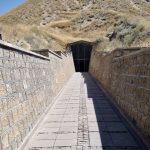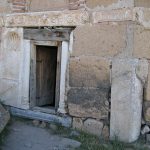Visitors to Turkey are often familiar with the Hittites and Phrygians. Far less well known are the Urartians who, from around the middle of the ninth century BC until the start of the sixth century BC, governed a kingdom that was centred on Van (then Tushpa) in the far east of Anatolia on the shores of what is now Lake Van. For most people the Urartians feature only as the makers of the magnificent metal cauldrons and engraved metal belts that are prized items in Ankara’s Museum of Anatolian Civilisations. But those whose itineraries take in the east of the country will find clear evidence of the Urartians not only in Van itself but also in nearby Çavuştepe, Ayarış and Toprakkale.
Several factors have combined to ensure that less is known about the Urartians than we might hope. In the first place, although Tushpa itself was in what is now Turkey, the Urartian kingdom actually straddled the boundaries of what are now Iraq and Iran and included most of what are now Armenia and Georgia. The complicated politics of this part of the world mean that of a known 300-odd Urartian sites, only half that number have actually been excavated, and of those very few are within Turkey.
Who exactly the Urartians were and where they came from remains uncertain although they seem to have replaced a people known as the Hurrians who had developed a kingdom called Mitanni in the same area. Luckily, the names of the kings of Urartu are known from the many inscriptions that they left behind. It’s also known that their earliest power struggles were mainly with the neighbouring Assyrians although ultimately they were overthrown by a combination of invading Cimmerians, Scythians and Medes. The whys and wherefores remain something of a mystery but ultimately much of Urartu was absorbed into the Kingdom of Armenia; most historians seem to agree that the last of the Urartians should be identified as proto-Armenians.
The Urartians had their own language which was written in Assyrian cuneiform and in other hieroglyphic forms that are yet to be translated. They worshipped almost a hundred different gods, with the main deity being the warrior Khaldi who is usually depicted standing on a lion. They also worshipped a thunder god named Theispas who appears to be the same as the Hittite god Teshuba. Great farmers who made much use of irrigation ditches, the Urartians were also wonderful metal workers who used the lost-wax process to make moulds for their beautiful cauldrons and axes.
Aside from the main sites listed below, the remains of Urartian castles have also been identified at Başkale, Çaldıran, Dereüstü (Anzaf Kalesi), Muradiye and Elmalık (Zivistan Kalesi). The remains of a harbour can be seen at Deliçay and of an open-air quarry at Gümüşdere (some of these sites may have been damaged during the Van-Erciş earthquakes of 2011). Slightly further away, the remains of Urartian settlements have also been excavated at Patnos, near Malazgirt, and at Altıntepe, near Erzincan.
Most important Urartian sites
Museum of Anatolian Civilisations, Ankara
Read more: BEST URARTIAN SITES


